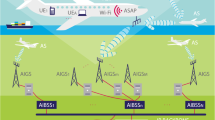Abstract
Currently aeronautical communications are extremely limited by the Aeronautical Telecommunications Network standard, which does not support the inter-aircraft communications directly. To this end, we consider an aeronautical ad-hoc network based on a single flight path, whereby the aircrafts in the cruise stage can communicate with each other through multi-hop relays without the aid of ground stations. Due to the special topology of this network model, existing results based on the conventional mobile ad-hoc networks are not applicable for determining its capacity scaling law. In this paper, we prove the upper bound on the per-node capacity and construct a simple transmission scheduling scheme to achieve the lower bound.







Similar content being viewed by others
Notes
The separation of two neighboring height levels is about 0.3 km except for some special cases where the separation is either 0.5 or 0.6 km.
References
The ATENAA Project, http://www.atenaa.org.
Civil aviation adminstration of china, http://www.caac.gov.cn/dev/fbs.
Aeronautical Radio, Inc. (June 2006). ARINC Specification 618–6: Air/Ground Character-Oriented Protocol Specification.
Agarwal, A., & Kumar, P. (2004). Capacity bounds for ad hoc and hybrid wireless networks. ACM SIGCOMM Computer Communication Review, 34(3), 71–81.
Franceschetti, M., Dousse, O., David, N., & Thiran, P. (2007). Closing the gap in the capacity of wireless networks via percolation theory. IEEE Transactions on Information Theory, 53(3), 1009–1018.
Grossglauser, M., & Tse, D. (2002). Mobility increases the capacity of ad hoc wireless networks. IEEE/ACM Transactions on Networking, 10(4), 477–486.
Gupta, P., & Kumar, P. (2000). The capacity of wireless networks. IEEE Transactions on Information Theory, 46(2), 388–404.
Kozat, U., & Tassiulas, L. (2003). Throughput capacity of random ad hoc networks with infrastructure support. In MobiCom’03, pp. 55–65. ACM.
Lin, X., & Shroff, N. (2004). Towards achieving the maximum capacity in large mobile wireless networks under delay constraints. Journal of Communications and Networks, 6(4), 352361.
Liu, B., Liu, Z., & Towsley, D. (2003). On the capacity of hybrid wireless networks. In INFOCOM’03, Vol 2, pp. 1543–1552.
Liu, B., Thiran, P., & Towsley, D. (2007). Capacity of a wireless ad hoc network with infrastructure. In MobiCom’07, pp. 239–246.
Mammen, J., & Shah, D. (2007). Throughput and delay in random wireless networks with restricted mobility. IEEE Transactions on Information Theory, 53(3), 1108–1116.
Medina, D., Hoffmann, F., Ayaz, S., & Rokitansky, C. (2008). Feasibility of an aeronautical mobile ad hoc network over the north atlantic corridor. In IEEE SECON’08, pp. 109–116.
Medina, D., Hoffmann, F., Ayaz, S., & Rokitansky, C. (2008). Topology characterization of high density airspace aeronautical ad hoc networks. In IEEE MASS’08, pp. 295–304.
Nekoui, M., Eslami, A., & Pishro-Nik, H. (2008). The capacity of vehicular ad hoc networks with infrastructure. In WiOPT 2008, pp. 267–272. IEEE.
Pishro-Nik, H., Ganz, A., & Ni, D. (2007). The capacity of vehicular ad hoc networks. In 45th Annual Allerton conference on communications, control and computing.
Sakhaee, E., & Jamalipour, A. (2006). The global in-flight internet. IEEE JSAC, 24(9), 1748–1757.
Sakhaee, E., Jamalipour, A., & Kato, N. (2006). Aeronautical ad hoc networks. In IEEE WCNC’06, Vol. 1, pp. 246–251.
Schnell, M., & Scalise, S. (2007). Newsky-concept for networking the sky for civil aeronautical communications. IEEE Aerospace and Electronic Systems Magazine, 22(5), 25–29.
Sharma, G., & Mazumdar, R. (2004). Scaling laws for capacity and delay in wireless ad hoc networks with random mobility. In IEEE ICC’04, Vol. 7, pp. 3869–3873.
Signore, T., & Girard, M. (1998). The aeronautical telecommunication network (atn). In MILCOM’98, Vol. 1, pp. 40–44.
VDL, I. (1997). mode 4 standards and recommended practices (version 5. 4). VDL SARPs WGD/6 [Z].
Yan, J., Song, G., Li, H., Hua, C., Chen, C., & Guan, X. (2012). Critical transmission range for connectivity in aeronautical ad-hoc, networks. In WCICA’12.
Zemlianov, A., & De Veciana, G. (2005). Capacity of ad hoc wireless networks with infrastructure support. IEEE Journal on Selected Areas in Communications, 23(3), 657–667.
Zhang, G., Xu, Y., Wang, X., Tian, X., Liu, J., Gan, X., et al. (2012). Multicast capacity for vanets with directional antenna and delay constraint. IEEE Journal on Selected Areas in Communications, 30(4), 818–833.
Acknowledgments
The work was partially supported by National Key Basic Research Program of China under the grant 2010CB731803, by NSF of China under Grant 61174127, 61371085 and 60932003, and by Key Laboratory of Wireless Sensor Network and Communication, Shanghai Institute of Microsystem and Information Technology, Chinese Academy of Sciences.
Author information
Authors and Affiliations
Corresponding author
Rights and permissions
About this article
Cite this article
Yan, J., Hua, C., Chen, C. et al. The capacity of aeronautical ad-hoc networks. Wireless Netw 20, 2123–2130 (2014). https://doi.org/10.1007/s11276-014-0737-7
Published:
Issue Date:
DOI: https://doi.org/10.1007/s11276-014-0737-7




